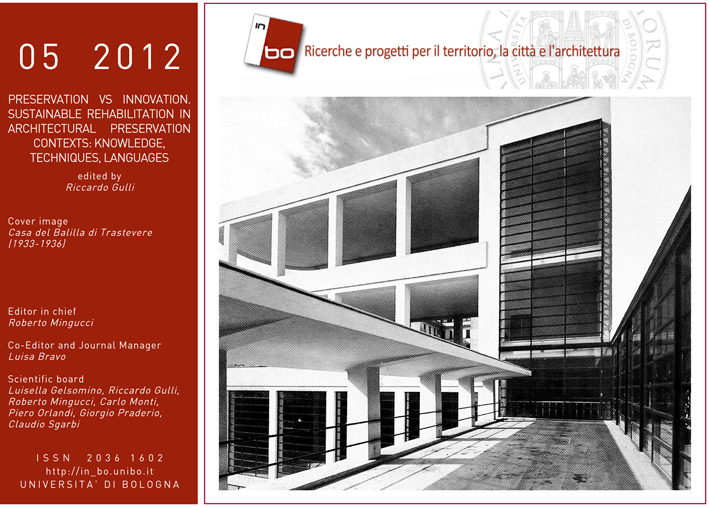Safety and innovation in building construction rehabilitation projects: the Building Information Modelling Approach
DOI:
https://doi.org/10.6092/issn.2036-1602/3490Keywords:
safety, building site, bim, construction, construction managementAbstract
Construction Rehabilitation Projects are often complex projects because of the specific building production environment. In fact the existing building structure is a constraint to project site layout organisation. So rehabilitation projects may need a major effort in safety design, due to new hazards and difficulties in standardization of building operations. The Building Information Modelling (BIM) approach can make a breakthrough for the rehabilitation construction project safety design because of construction phases simulation and visualization. The construction modelling process allows safety designers to better perform hazards evaluation and risks analysis, and to better evaluate the designed safety solutions, even if complete efficiency of BIM solutions for project safety design are still to achieve.
References
Bansal V.K. (2011), Application of Geographic information systems in construction safety planning, International Journal of Project Management 29 (2011) pp. 66-77
Battistini G. (2012), “BIM – Building Information Modeling per la programmazione e la sicurezza dei cantieri. Il caso della ricostruzione del teatro A. Galli di Rimini”, tesi di laurea magistrale in ingegneria edile – architettura, Relatore Prof. M. Bragadin, Correlatori Prof. C. Galli e Prof. R. Mingucci, Facoltà di Ingegneria dell’Università di Bologna
Bragadin M. (2012), Building Information Modelling e Sicurezza, in atti del Convegno annuale sicurezza CPTO IIPLE Bologna 2012, AMS ACTA Università di Bologna
Cabinet Office British Government (2010), Government Construction Strategy, London
Ciribini A., Manto S. (2011), Project Sponsorship, la committenza e le condizioni di integrazione, Swedish Construction Clients Forum
Comani C. (1999), Relazione introduttiva in Atti del Convegno “Il recupero delle emergenze storiche della città”, DAPT Bologna 1996
De Luca Picione M., Dell’Osso G.R. (2010), Simulazione e modellazione con il Building Information Modeling del cantiere edile negli interventi di recupero sul costruito, Atti del Convegno ISTEA 2010 Isola d’Elba, giugno 2010
Gambatese J. A., Hinze J. W., Haas C. T. (1997), Tool to design for Construction Worker Safety, Journal of Architectural Engineering vol. 3 n.1 march 1997
Gao J., Fischer M., Tollefsen T. Haugen T., (2005), Experiences with 3D and 4D CAD on Building Construction Projects: Benefits for Project Success and Controllable Implementation Factors, Proceedings of CIB W078 22nd Conference on Information Technology in Construction, 2005 Dresden
Garagnani S., Cinti Luciani S., Mingucci R. (2011), Building Information Modelling: la tecnologia digitale al servizio del progetto di architettura, DISEGNARECON, 4(7), 5 - 19, doi:10.6092/issn.1828-5961/2297
Kiviniemi M., Sulankivi K., Kahkonen K., Makela T., Merivirta M.L. (2011), BIM-based Safety Management and Communication for Building Construction, VTT research notes 2597, VTT Finland
Ku K., Mills T. (2011), Research Needs for Building Information Modeling for Construction Safety, International proceedings of Associated Schools of Construction. 45th Annual Conference, Boston, MA
UNI 10914/1 (2001), Edilizia. Qualificazione e controllo del progetto edilizio di intervento di nuova costruzione e di interventi sul costruito
Vacharapoom B., Sdabhon B. (2010), An integrated safety management with construction management using 4D CAD model, Safety Science, No. 48
Zhou W. Whyte J. Sacs R. (2012), Construction safety and digital design: a review, Automation in construction 22 (2012) pp. 102-111
Downloads
Published
How to Cite
Issue
Section
License
Copyright (c) 2012 Marco Alvise Bragadin
Copyrights and publishing rights of all the texts on this journal belong to the respective authors without restrictions.
This journal is licensed under a Creative Commons Attribution-NonCommercial 4.0 International License (full legal code).
See also our Open Access Policy.
Metadata
All the metadata of the published material is released in the public domain and may be used by anyone free of charge. This includes references.
Metadata — including references — may be re-used in any medium without prior permission for both not-for-profit and for-profit purposes. We kindly ask users to provide a link to the original metadata record.







